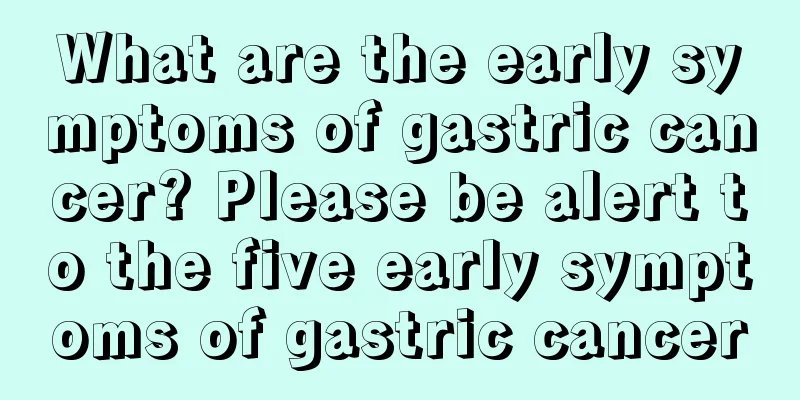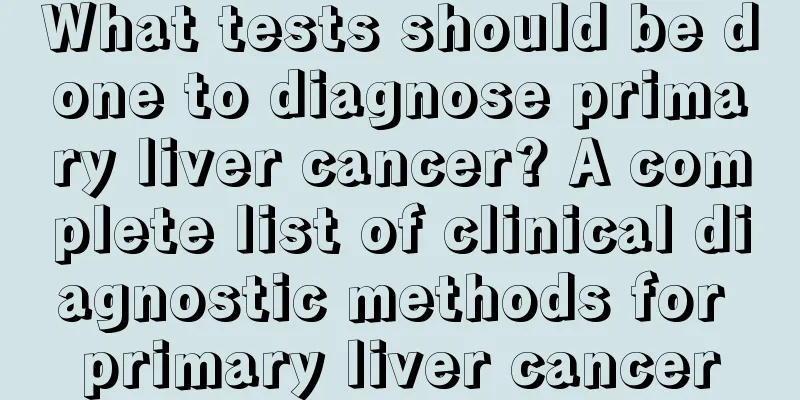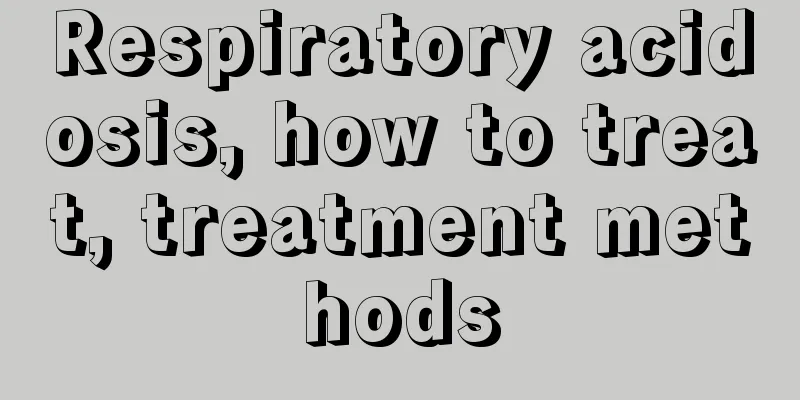What are the early symptoms of gastric cancer? Please be alert to the five early symptoms of gastric cancer

|
Gastric cancer is one of the most common malignant tumors in my country. Its incidence rate ranks first among all kinds of tumors in my country. About 170,000 people die of gastric cancer every year, which is almost 1/4 of the total number of deaths from malignant tumors. In addition, more than 20,000 new gastric cancer patients are produced every year. Gastric cancer is indeed a disease that seriously threatens people's health. Gastric cancer can occur at any age, but it is more common in 40 to 60 years old. There are more men than women, about 2:1. Gastric cancer can occur in any part of the stomach, but it is more common in the gastric antrum, especially the lesser curvature of the stomach. The average life expectancy of untreated patients is about 13 months. As the disease progresses, the function of the stomach and the general condition gradually change. These symptoms are often non-specific, can appear from time to time, and can exist for a long time. Such as upper abdominal distension, dull pain, dull pain, nausea, loss of appetite, belching and weight loss, etc. A small number of ulcer-type (type IIc and type III) early gastric cancers may also have ulcer-like symptoms, rhythmic pain, acid reflux, which can be relieved by medical treatment. Clinical manifestations Early gastric cancer often has no symptoms or only mild symptoms. When clinical symptoms become obvious, the disease is already in the late stage. Therefore, we must be very vigilant about the early symptoms of gastric cancer to avoid delaying diagnosis and treatment. 1. Symptoms Early Gastric Cancer As the disease progresses, the function of the stomach and the general condition gradually change. These symptoms are often non-specific, may appear from time to time, and may exist for a long time. Such as upper abdominal distension, dull pain, dull pain, nausea, loss of appetite, belching and weight loss, etc. A small number of ulcer-type (type IIc and type III) early gastric cancers may also have ulcer-like symptoms, rhythmic pain, acid reflux, which can be relieved by medical treatment. Some patients have gastric cancer coexisting with certain benign lesions or canceration on the basis of certain benign lesions (such as chronic atrophic gastritis, peptic ulcer, etc.), and the symptoms of these benign gastric diseases have existed for a long time, or recurred, which makes it easier for patients and doctors to relax their vigilance against gastric cancer and delay the diagnosis. Some early gastric cancers may also present with symptoms such as vomiting blood, black stools, or difficulty swallowing and seek medical treatment. ① Upper abdominal discomfort: It is the most common initial symptom of gastric cancer. About 80% of patients have this symptom, which is similar to indigestion. If abdominal pain occurs, it is generally mild at the beginning and irregular. It cannot be relieved after eating and gradually worsens. It can be dull pain. Some may have rhythmic pain, especially in gastric antral gastric cancer, which can even be relieved by eating or taking medicine. Elderly people have dull pain perception and often complain of abdominal distension. These symptoms are often not taken seriously by patients, and they are easily mistaken for gastritis or ulcer disease when seeking medical treatment. Therefore, middle-aged patients should be given further examinations if they have the following conditions to avoid missed diagnosis: A. No history of gastric disease, but recent unexplained upper abdominal discomfort or pain, which is ineffective after treatment; B. A history of gastric ulcer, recent regular changes in upper abdominal pain, and the degree is getting worse. If the symptoms are relieved, but there are recurrences in a short period of time, the possibility of gastric cancer should also be considered, and further examinations should be carried out in time. ② Loss of appetite or poor appetite: Loss of appetite and weight loss are the second most common symptoms of gastric cancer. Nearly 50% of gastric cancer patients have obvious symptoms of loss of appetite or poor appetite. Some patients restrict their food intake because eating too much will cause abdominal distension or abdominal pain. Unexplained anorexia and weight loss are likely to be the initial symptoms of early gastric cancer and need to be taken seriously. Patients with early gastric cancer generally have no obvious positive signs. Most patients have only deep tenderness in the upper abdomen in addition to weak general condition. (2) Advanced gastric cancer Gastric cancer lesions grow from small to large, from shallow to deep, and from no metastasis to metastasis in a gradual process. Therefore, there is no clear boundary between the early stage, advanced stage and even the late stage. Not only that, the symptoms between the stages often overlap greatly. Some patients have already reached the advanced stage, but the symptoms are not obvious. Some patients have more prominent symptoms even though they are in the early stage. Some patients seek medical treatment for symptoms of organ metastasis or complications. According to domestic data statistics, the common symptoms of advanced gastric cancer are as follows: ① Abdominal pain: When gastric cancer develops and expands, especially when it infiltrates through the serosa and invades the pancreas or transverse colon mesentery, persistent severe pain may occur and radiate to the waist and back. Very few patients with perforated cancerous ulcers may also experience severe abdominal pain and signs of peritoneal irritation. ② Loss of appetite and weight loss: The absorption of cancer toxins can cause the patient to become increasingly emaciated, weak, anemic, and malnourished. These symptoms often progressively worsen and eventually manifest as cachexia. ③ Nausea and vomiting: It is also one of the more common symptoms and can occur in the early stage. Antral cancer can also cause symptoms of pyloric obstruction. ④ Vomiting blood and black stools: When ulcers form on the surface of the tumor, vomiting blood and black stools will occur. One-third of gastric cancer patients often have a small amount of bleeding, which is often manifested as positive occult blood in the stool. Some may have intermittent black stools, but there are also patients who seek medical treatment for a large amount of vomiting blood. ⑤ Diarrhea: It may be related to low stomach acid. The stool may be mushy and even have diarrhea at dawn. When advanced gastric cancer involves the colon, it can often cause diarrhea, bloody stool, etc. ⑥ Difficulty in swallowing: When the cancer grows larger, obstruction symptoms may appear. Cancer of the cardia or fundus of the stomach can cause difficulty in swallowing, and cancer of the antrum of the stomach can cause symptoms of pyloric obstruction. 2. Physical signs Early gastric cancer may not cause any physical signs. Or there may only be tenderness in the upper abdomen. Most patients with mid- to late-stage gastric cancer will have obvious tenderness in the upper abdomen. One-third of patients can feel a lump in the abdomen, which is hard, uneven, and tender. This is especially true for thin patients with antral cancer, who are more likely to find the lump. Metastatic lesions, such as a lump before the rectum, a lump in the umbilicus, enlarged supraclavicular lymph nodes, and the presence of ascites, are evidence of advanced gastric cancer. Upper abdominal mass, prerectal crypt mass, umbilical mass, left supraclavicular lymphadenopathy, left axillary lymphadenopathy, ascites, etc. often indicate distant metastasis. Corresponding signs often appear due to different metastatic sites, making the clinical manifestations very complicated. For example, liver metastasis may cause hepatomegaly and jaundice, ovarian metastasis may cause ovarian enlargement and a large amount of ascites, and lung metastasis may cause dyspnea. In addition, gastric cancer paraneoplastic syndrome can also become an important sign, such as thrombophlebitis, dermatomyositis, etc. Late-stage patients may have fever, cachexia, etc. Regional environment and dietary factors (30%): There are obvious regional differences in the incidence of gastric cancer. The incidence of gastric cancer in the northwest and eastern coastal areas of my country is significantly higher than that in the southern region. The incidence of distal gastric cancer is high among people who have long consumed smoked, roasted, and salted foods, which is related to the high content of carcinogens or pro-carcinogens such as nitrites, fungal toxins, and polycyclic aromatic hydrocarbons in food. The risk of gastric cancer in smokers is 50% higher than that in non-smokers. Helicobacter pylori infection (20%): The Hp infection rate among adults in high-incidence areas of gastric cancer in my country is over 60%. Helicobacter pylori can promote the conversion of nitrates into nitrites and nitrosamines, which are carcinogenic. Hp infection causes chronic inflammation of the gastric mucosa, and environmental pathogenic factors accelerate the excessive proliferation of mucosal epithelial cells, leading to aberration and carcinogenesis. The toxic products of Helicobacter pylori, CagA and VacA, may have a carcinogenic effect. The detection rate of anti-CagA antibodies in gastric cancer patients is significantly higher than that in the general population. Precancerous lesions (20%): Gastric diseases include gastric polyps, chronic atrophic gastritis, and residual stomach after partial gastrectomy. These lesions may be accompanied by varying degrees of chronic inflammatory processes, intestinal metaplasia or atypical hyperplasia of the gastric mucosa, and may turn into cancer. Precancerous lesions refer to pathological histological changes in the gastric mucosa that are prone to canceration. They are borderline pathological changes in the process of transformation from benign epithelial tissue to cancer. Dysplasia of the gastric mucosal epithelium is a precancerous lesion. It can be divided into three degrees: mild, moderate, and severe according to the degree of cell atypia. Severe dysplasia is sometimes difficult to distinguish from well-differentiated early gastric cancer. Heredity and genes (10%): Genetic and molecular biology studies have shown that the incidence of gastric cancer in blood relatives of gastric cancer patients is 4 times higher than that in the control group. The carcinogenesis of gastric cancer is a multi-factor, multi-step, and multi-stage development process involving changes in oncogenes, tumor suppressor genes, apoptosis-related genes, and metastasis-related genes, and the forms of gene changes are also diverse. 1. Primary prevention (1) Pay attention to food hygiene and avoid eating too much stimulating food and smoked products. Control smoking and drinking, eat on time, and avoid overeating to reduce the occurrence of gastritis and gastric ulcers. (2) Change the traditional methods of preserving food such as salting or smoking, and widely use freezing and fresh-keeping storage methods. (3) Reduce salt intake in food and control daily intake to less than 6g. (4) Eat fresh vegetables and fruits regularly. (5) Eat more milk and dairy products. 6) Increase the protein content of fresh fish, meat, etc. in food. (7) Eat garlic regularly. (8) Eradication of HP infection in the stomach. Patients with gastric ulcers or gastric polyps larger than 2 cm that have not responded to long-term treatment should receive timely surgical treatment, and patients with atrophic gastritis should undergo regular follow-up gastroscopy examinations, which are of certain preventive significance. Research shows that: ①Cancer cannot form in a weakly alkaline human body. ②Cancer can only form in an acidic body. ③If you have cancer, it means your body is acidic. ④Cancer can only grow in an acidic body. ⑤If your body becomes less alkaline, cancer cannot spread. ⑥If you can balance your body's pH value and make your body weakly alkaline, no matter what cancer you have, it can be transformed and cured. ⑦ No matter how bad your condition is, even if you can only live for 6 months, if you can change your body's pH value to slightly alkaline, your cancer will not spread and you will get better. ⑧Don’t worry that your mom, dad or anyone in your family has cancer. As long as your body is weakly alkaline, you won’t get it. If you already have it, it will change. ⑨Cancers live in acidic body fluids, nothing else. If your body is acidic, you will get cancer. If it is weakly alkaline, you will not get cancer. If you already have cancer, as long as you can adjust the pH value of your body to weakly alkaline, cancer will leave you. The secret to preventing cancer is very simple, which is to eat alkaline foods regularly to prevent the accumulation of acidic waste, because the acidified body fluid environment is fertile soil for normal cells to become cancerous. Adjusting the acid-base balance of body fluids is an effective way to prevent cancer. A) Develop good living habits, quit smoking and limit alcohol consumption. The World Health Organization predicts that if people stop smoking, the number of cancer cases in the world will be reduced by 1/3 in 5 years. Secondly, do not drink excessively. Tobacco and alcohol are extremely acidic substances. People who smoke and drink for a long time are very likely to develop an acidic constitution. B) Do not eat too much salty and spicy food, and do not eat overheated, overcooled, expired or spoiled food; the elderly and weak or those with a genetic disease should eat some anti-cancer food and alkaline food with high alkaline content as appropriate to maintain a good mental state. C) Have a good attitude to deal with stress, combine work and rest, and avoid excessive fatigue. It can be seen that stress is an important cause of cancer. Traditional Chinese medicine believes that stress leads to physical weakness due to overwork, which in turn causes decreased immune function, endocrine disorders, metabolic disorders in the body, and the deposition of acidic substances in the body; stress can also lead to mental tension, causing qi stagnation and blood stasis, and internal toxic fire. D) Strengthen physical exercise, improve physical fitness, exercise more in the sun, and sweat more to excrete acidic substances in the body with sweat, avoiding the formation of an acidic constitution. E) Live a regular life. People with irregular living habits, such as singing karaoke all night, playing mahjong, and staying out all night, will increase the acidification of the body and be more likely to get cancer. You should develop good living habits to maintain a weakly alkaline body and keep various cancer diseases away from you. F) Do not eat contaminated food, such as contaminated water, crops, poultry, fish eggs, moldy food, etc. Eat some green organic food to prevent diseases from entering the body through the mouth. 2. Secondary prevention (1) Conducting a population survey in areas with a high incidence of gastric cancer: This is an important way to detect early gastric cancer. The key to gastric cancer prevention lies in early detection. The survey is an important measure for early detection of gastric cancer. Anyone over the age of 40, with a long history of gastric disease, or who has had obvious gastric symptoms in recent months, should be included in the survey. In recent years, China has done a lot of work in the research and establishment of a gastric cancer screening method suitable for my country's national conditions, and has made certain progress. There are two main methods. One is to use a computer to identify the pattern of medical history and symptoms, and the other is to use small balls made of various materials to collect fasting gastric juice, and then perform occult blood or biochemical tests. (2) Establishing a gastric disease clinic to reduce missed and misdiagnosed patients is another way to detect gastric cancer early. Since early gastric cancer often has no obvious symptoms, and the symptoms of mid- and late-stage gastric cancer are also non-specific, it is easy to be misdiagnosed as chronic gastric diseases such as gastritis or gastric ulcers. In summary, among the cases of gastric cancer diagnosed with symptoms in China, only 29% were diagnosed within three months, and 33% were diagnosed after more than one year. Even in Shanghai, where the medical level is relatively high, the average time from the first visit to the hospital for gastric cancer to the diagnosis is 113 days, and 26.2% of the cases were diagnosed after more than four months of visit. Therefore, how to improve the early diagnosis rate of patients coming to the hospital and reduce the time of misdiagnosis in the hospital is another key to improving the treatment effect of gastric cancer. According to foreign experience, after the establishment of a digestive specialist clinic, the proportion of early gastric cancer can be increased from the original 1.6% to 10.60%. In all hospitals in China that have digestive specialists, the proportion of early gastric cancer is 10% to 180%, which is much higher than the 1.2% to 2.7% of general hospitals. Therefore, hospitals with the conditions should set up specialized gastric disease clinics and strengthen the examination of patients who come to the hospital with gastric symptoms. In particular, for patients with first diagnosis or a long medical history and at a high-risk age, gastroscopy or barium meal examination should be performed to reduce missed diagnoses and increase the early diagnosis rate of gastric cancer in outpatients. (3) Follow up susceptible cases: Patients with atrophic gastritis, gastric polyps, gastric ulcers, remnant stomachs, moderate to severe atypical hyperplasia, and incomplete colonic intestinal metaplasia are known to have a higher incidence of gastric cancer. Therefore, active treatment and regular follow-up examinations of the above-mentioned precancerous conditions and precancerous lesions are another way to detect gastric cancer early. Some scholars believe that surgical treatment can be used for chronic gastric ulcers that have not healed for a long time or have severe scarring, multiple gastric polyps, single polyps with a diameter greater than 2 cm, and severe atypical hyperplasia that have not healed after long-term medical treatment or have severe scarring, because they have a high tendency to become cancerous. For the follow-up of the remnant stomach, some people suggest: ① For those who underwent surgery before the age of 40, the procedure should be performed once a year starting from 20 years after surgery. ② For those who undergo surgery after the age of 40, the surgery should be performed once a year starting from 10 years after the surgery. ③For patients with chronic bile reflux, do it once a year starting from 10 years after surgery. Gastric cancer follows the principle of early detection and early treatment. There are many ways to treat gastric cancer, and different treatment methods are used in different stages. Early gastric cancer is mainly treated by surgery, and drug treatment is given according to the patient's symptoms after treatment. The treatment of mid- and late-stage gastric cancer mainly plays a relieving role, and conservative treatment is used to prolong the patient's life, alleviate the patient's condition, and improve the patient's quality of life. should 1. It is advisable to eat more foods that can enhance immunity and fight stomach cancer, such as yam, lentils, coix seed, water chestnut, day lily, shiitake mushrooms, mushrooms, sunflower seeds, kiwi, figs, apples, sardines, honey, pigeon eggs, milk, pork liver, sandworms, hericium erinaceus, abalone, needle fish, sea cucumber, oyster, squid, shark, tiger fish, yellow croaker maw, seahorse, and turtle. 2. It is advisable to eat more high-nutrition foods to prevent and treat cachexia, such as black-bone chicken, pigeon, quail, beef, pork, rabbit meat, eggs, duck, fermented black beans, tofu, silver carp, grass carp, knife fish, catfish, black carp, yellow croaker, squid, crucian carp, eel, dace, pomfret, loach, shrimp, mussels, pork liver, and sturgeon. 3. In case of nausea and vomiting, you should eat water shield, grapefruit, orange, loquat, corn, walnut, rose, carambola, fig, ginger, lotus root, pear, winter vegetables, mango, black plum and lotus seeds. 4. People with anemia should eat clams, turtle, shark, shark fin, amaranth, day lily, hericium erinaceus, honey, shepherd's purse, bananas, olives, black plums, fungus, sheep's blood, broad bean skins, sesame, persimmon cake, tofu dregs, snails, etc. 5. People with diarrhea should eat shark, lentils, pears, bayberry, taro, chestnuts, pomegranates, lotus seeds, water chestnuts, herring and white hibiscus. 6. Kumquat, cabbage, flounder, horseshoe crab, toad fish, sandworms, sea cucumber, squid, yellow sprouts and taro flowers are suitable for people with abdominal pain. 7. Foods that prevent and treat the side effects of chemotherapy: kiwi, asparagus, longan, walnut, crucian carp, shrimp, crab, goat blood, goose blood, jellyfish, grass carp, catfish, shiitake mushrooms, black fungus, quail, coix seed, mud snail, mung bean, day lily, apple, loofah, walnut, turtle, soft-shelled turtle, black plum, apricot cake, and fig. avoid 1. Avoid eating moldy, rotten or spoiled food. 2. Avoid high-salt diet. 3. Avoid eating overly irritating foods, such as chili peppers, peppercorns, etc. 4. Avoid smoking and drinking. 5. Patients after surgery should avoid milk, sugar and high-carbohydrate foods to prevent dumping syndrome. 6. Eat less or no smoked or grilled foods and over-pickled vegetables. 7. Avoid eating spicy foods, such as coriander, cumin, pepper, chili, onion, mustard, garlic, etc. 8. Fatty and phlegm-producing foods: such as fatty meat, fat chicken, fat duck, various sweets with high sugar content, cream and cheese, etc. 9. Foods that are considered "irritating" by traditional Chinese medicine include: mutton, scaleless fish, pork head, animal offal, seafood such as shrimp and crab, rooster, dog meat, silkworm pupae, etc. 10. Avoid smoking and drinking. Tobacco and alcohol can only make the disease progress faster and have no benefits but only harms. |
<<: What are the symptoms of pituitary tumors? What causes pituitary tumors?
Recommend
Honey is half crystallized and half liquid
When most people buy honey, they will buy a lot a...
What are the symptoms of spinal ligament injury
The spine is regarded as the most important part ...
Analysis of the sites of imaging examination for lymphoma
Like many early symptoms of malignant tumors, lym...
Causes of anastomotic leakage after rectal cancer surgery
The most important issue in surgical treatment of...
What are the causes of skin cancer?
What are the causes of skin cancer? I believe man...
Toothpaste is not just for brushing your teeth—32 unusual uses!
Is a small piece of toothpaste only used for brus...
What to do if a young person has hunchback
If your friends have hunchbacks, they can receive...
The dangers of bringing lunch to office workers
Due to the high pressure of modern life, many off...
What kind of tampons are easy to use
Everyone has their own experience in choosing san...
A red mark suddenly appears on your face?
Allergic dermatitis is a very common disease in d...
How to clean scale in hot water pipes
There will be a lot of scale in the hot water pip...
Is fatty liver contagious to humans?
Fatty liver is a common disease, but it is not a ...
Does eating pomegranate have a diuretic effect?
Eating more pomegranates is very beneficial to th...
Are blisters caused by eczema? How to prevent and treat it?
Blistering eczema is the most common type of skin...
Is it better to have a thick or thin placenta?
When a woman is pregnant for a certain period of ...









